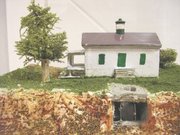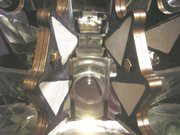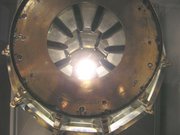What the new exhibit about Jones Point lighthouse at the Lyceum lacks in volume, it compensates with scale. The museum is displaying two enormous Fresnel lenses — giving viewers an up-close-and-personal look at how the old lighthouse worked. The exhibit also features several interpretive panels and a model of the lighthouse grounds to give viewers some context about the famous lighthouse situated at the southern tip of the District of Columbia.
For those who love the romantic attraction of lighthouses, this exhibit is a rare chance to witness two different "orders" of the gigantic objects, and one of the lenses was actually used at the Jones Point lighthouse. The exhibit will remain at Alexandria’s history museum on South Washington Street through February.
"People come in here and say they would love to use one of these as a chandelier, but that would never work because they are so heavy," said Pam Budde, visitor services coordinator at the Lyceum. "They would probably rip your ceiling off."
The barrel-shaped objects were not made for decoration. Invented by French physicist Augustin-Jean Fresnel in the early 19th century, the lenses use a series of prisms to concentrate the light source and direct it into a narrow horizontal beam. The two Fresnel lenses on display at the Lyceum recently underwent a 13-month restoration by the Chesapeake Lighthouse Society, which involved using cotton swabs, wooden chopsticks, bamboo skewers and Popsicle sticks.
"Sometimes we had to carve the Popsicle sticks into different shapes to get into the areas we needed to clean," said Marie Vincent, membership chairwoman of the Chesapeake Chapter of the United States Lighthouse Society. "It was definitely a labor of love, and one that required quite a great deal of creativity."
<b>THE NARROW STRIP</b> of land at the southern tip of Old Town has been used by local people for more than 5,000 years. The area has been used for hunting, fishing, farming, shipbuilding and recreation. But the most prominent structure in the area is an 1856 lighthouse that was originally commissioned by the United States Department of the Treasury. For the better part of a century, the building was an important navigational tool for those traveling the river and a home for the caretaker and his family. It was deactivated in 1926, when it was acquired by the Mount Vernon Chapter of the Daughters of the American Revolution.
"There are only five lighthouses left on the Potomac," said then-Councilman Andrew Macdonald during a 2006 ceremony marking the 150th anniversary of the lighthouse’s construction. "I’m hopeful we will be able to turn it into a city museum."
Macdonald’s vision of turning the building into a museum has not been realized, although federal funding has been secured to restore the exterior of the building. The National Park Service, which administers Jones Point as part of the George Washington Memorial Parkway, plans to reopen the park with new facilities and a redesigned park in the spring of 2011. Until then, those who need to get their lighthouse fix can come to the Lyceum and see the Fresnel lens that greeted visitors many years ago.
"We wanted to put brighter lights in them," said Budde. "But we found out that the lights would end up blinding everybody because they would do what they are designed to do."



